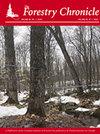山毛榉剪切/高树桩以控制林下干扰
IF 0.8
4区 农林科学
Q3 FORESTRY
引用次数: 3
摘要
该研究评估了在地面以上0.6-0.9米处切断小型林下山毛榉根系吸盘的机会。在一个封闭的树冠不均匀老化的北方硬木林中,用剪枝剪进行切割六年后(试点测试),91%缺乏剩余活枝的高树桩已经死亡。在那些被砍到最低的树枝上的人中,所有人都活了下来。在后来的一次操作试验中,合同工作人员在选择系统切割前的两个生长季节使用链锯,75%没有剩余活树枝的高树桩在第五年就已经死亡。在最初发芽的最低活枝条下切下的树桩中,只有7%在第六年有活枝条。在最低枝条上方切割的高树桩中,84%存活下来。本文章由计算机程序翻译,如有差异,请以英文原文为准。
Beech shearing/high-stumping to control understory interference
The research evaluated opportunities for cutting off small understory beech root suckers at 0.6-0.9 m above ground. By six years (pilot test) after cutting with lopping shears in a closed-canopy uneven-aged northern hardwood stand, 91% of high stumps lacking a residual live branch had died. Of those cut above the lowest living branch, all survived. In a later operational trial by contract crews using chainsaws two growing seasons before a selection system cutting, 75% of high stumps without a residual live branch had died by the fifth year. Of stumps cut below the lowest living branch and that initially sprouted, only 7% had a live sprout by the sixth year. Among high stumps cut above the lowest branch, 84% survived.
求助全文
通过发布文献求助,成功后即可免费获取论文全文。
去求助
来源期刊

Forestry Chronicle
农林科学-林学
CiteScore
1.20
自引率
0.00%
发文量
6
审稿时长
18-36 weeks
期刊介绍:
The Canadian Institute of Forestry has published The Forestry Chronicle, a professional and scientific forestry journal, since 1925. The Forestry Chronicle is published to provide information to forest practitioners about professional and scientific management of forests and their resources. The Forestry Chronicle provides forest practitioners in Canada and around the world with a means to communicate with their peers in the professional community.
 求助内容:
求助内容: 应助结果提醒方式:
应助结果提醒方式:


